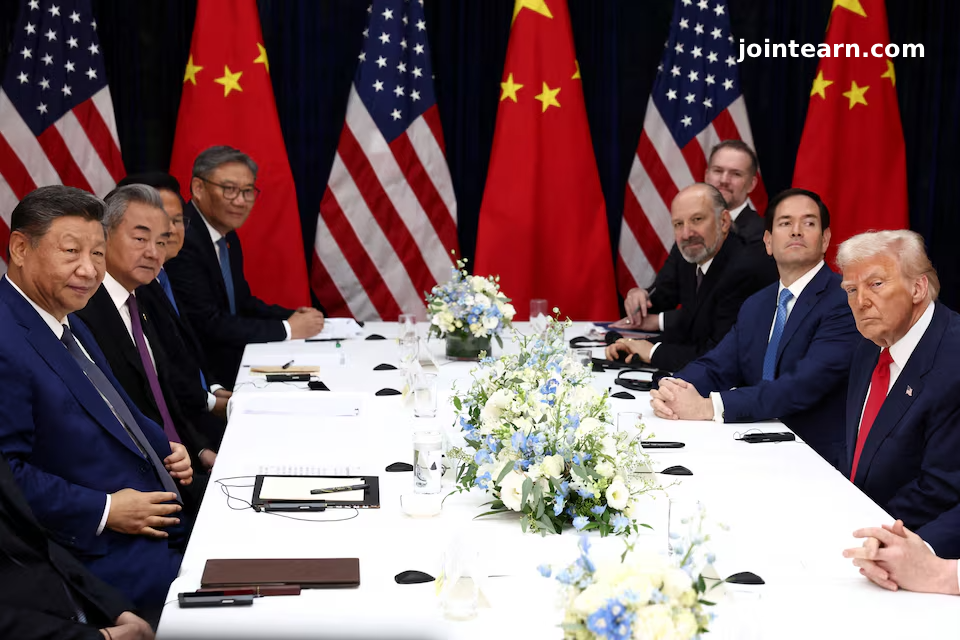
U.S. and China Agree to Cut Tariffs and Ease Trade Tensions
BUSAN, South Korea — October 30, 2025:
In a major step toward easing economic tensions between the world’s two largest economies, U.S. President Donald Trump announced that he and Chinese President Xi Jinping reached a deal to reduce U.S. tariffs on Chinese imports from 57% to 47%. The agreement also includes Chinese commitments to curb the flow of fentanyl, resume American soybean purchases, and suspend new rare earth export curbs for one year.
The announcement came following a nearly two-hour meeting between the two leaders in Busan, South Korea, on the sidelines of the Asia-Pacific Economic Cooperation (APEC) summit — marking their first face-to-face talks since 2019. Trump described the encounter as “an amazing meeting,” giving it “a 12 out of 10” rating during remarks aboard Air Force One.
Tariff Reductions Tied to Fentanyl Crackdown
Trump said the tariff cut was linked to Xi’s pledge to “work very hard” to stop the illicit trade in fentanyl precursor chemicals, a key driver of the U.S. opioid epidemic. Fentanyl remains the leading cause of overdose deaths in the United States, and the move was framed as a “life-saving” victory by the administration.
“This is about protecting American lives and rebuilding fair trade,” Trump said. “China has agreed to take aggressive action on fentanyl, and we are responding in kind by easing some tariff pressure.”
Rare Earths and Agricultural Trade Back in Focus
As part of the agreement, China’s Commerce Ministry confirmed it will pause rare earth export restrictions announced earlier this month — a major relief for U.S. industries reliant on these critical minerals used in electric vehicles, defense systems, and consumer electronics. The suspension will last one year, giving both sides time to negotiate a long-term framework.
The two countries also pledged to expand agricultural cooperation, including resuming large-scale soybean purchases by Chinese importers. Both leaders agreed to continue working on resolving issues related to TikTok’s U.S. ownership transfer, which Trump has sought to bring fully under American control.
Global Markets React Cautiously
Despite the breakthrough, global financial markets remained subdued. The Shanghai Composite Index slipped slightly from a decade high, and U.S. soybean futures weakened.
“The response from markets has been cautious in contrast to Trump’s enthusiastic characterization of the meeting,” said Besa Deda, chief economist at William Buck Advisory in Sydney.
Meanwhile, U.S. Senate Democratic Leader Chuck Schumer criticized the deal on social media platform X, writing, “Trump folded on China.”
Trade Detente Comes After Months of Escalation
The Busan summit followed a flurry of negotiations across Asia, where Trump touted new trade agreements with South Korea, Japan, and Southeast Asian nations. U.S. negotiators had earlier confirmed a framework deal with China to avoid 100% tariffs and defer rare earth restrictions, setting the stage for this week’s accord.
The meeting was cordial and symbolic of a broader reset in U.S.–China trade relations, which had deteriorated since Trump’s so-called “Liberation Day” offensive in April triggered retaliatory trade measures.
“China’s development and rejuvenation are not incompatible with President Trump’s goal of making America great again,” Xi told Trump, according to Chinese state media.
Beyond Trade: Energy, Defense, and Geopolitics
Trump announced on Truth Social that China will begin purchasing U.S. energy, referencing a potential $44 billion LNG export project in Alaska. Both sides also agreed to pause mutual port fees that had been part of a maritime logistics dispute.
However, sensitive topics such as Taiwan and advanced semiconductor exports were notably absent from the discussion. Trump confirmed that Nvidia’s Blackwell chip — central to the U.S.–China AI technology standoff — “was not discussed” during the meeting.
Minutes before the summit, Trump ordered the U.S. military to resume nuclear weapons testing after a 33-year hiatus, citing threats from Russia and China. Beijing responded by expressing hope that Washington would adhere to its moratorium.
Analysts Warn of Fragile Truce
While the deal marks a de-escalation, analysts caution that underlying trade tensions remain unresolved. Many see the current arrangement as a temporary truce, giving both sides breathing room ahead of 2026 trade negotiations.
“This is a détente, not a peace treaty,” said one Washington trade analyst. “Tariffs have eased, but the structural rivalries in technology, defense, and supply chains are still very much alive.”
Leave a Reply